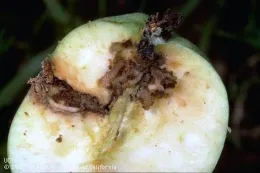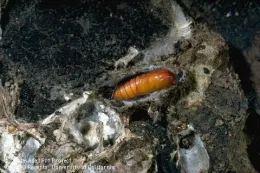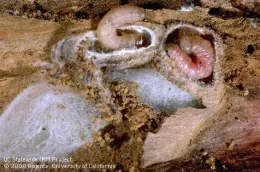Don't Let Codling Moths Ruin Your Apples

If you decide to fight them, now is a good time to plan your strategy since the most critical time to protect your fruit from the pest is spring. Warm spring weather causes most of the first generation moths to emerge within a few weeks. The moths may take 6 weeks or more to emerge during a cool spring. Once they have emerged, the codling moths are still affected by temperature. They do not lay eggs or mate when it's below 62°F at sunset or fly when it's 55°F.
The moths emerge from pupae in early spring about the time when fruit trees are in full bloom. Each moth lays 50 to 75 eggs on fruit, twigs, or leaves. Eggs hatch into larvae which tunnel into the young fruit. Inside the fruit, the larvae feed for several weeks, then tunnel to the fruit's surface and search for protected sites such as under tree bark, in branch wounds, weeds, grass or other litter. The larvae changes first to a pupa, then to an adult and repeats the cycle.

You can also trap many larvae under bands. Take a 6-inch wide strip or burlap or corrugated cardboard, wrap it around the trunk several times, then fasten it in place with a loop of wire or twine. If you use corrugated cardboard, the exposed flutes (ridges) must be at least 3/16 of an inch wide and face toward the tree; otherwise, the larvae won't form cocoons in them. Place a band on each tree no later than mind-May. During warm weather remove the band once a week, and during cool weather once every two weeks. Destroy all the larvae and pupae under the band, and then put the band back on the tree. Keep doing this until you've harvested all the fruit.

Insecticidal sprays are usually the most effective means of controlling codling moths. Sprays give best control when you apply them just after a large number of larvae hatch, but before they burrow into the fruit. These times are several days after a period of peak moth flight and vary according to the year and location.
When using any chemical, carefully follow dilution rates and other directions given on the container label. Do not spray within the number of days before harvest indicated on the label. You can read more details about the life cycle of this pest and management, including chemical controls in the UC IPM Pest Notes: Codling Moth.
Ed Perry is the emeritus Environmental Horticultural Advisor for University of California Cooperative Extension (UCCE) in Stanislaus County where he worked for over 30 years.
